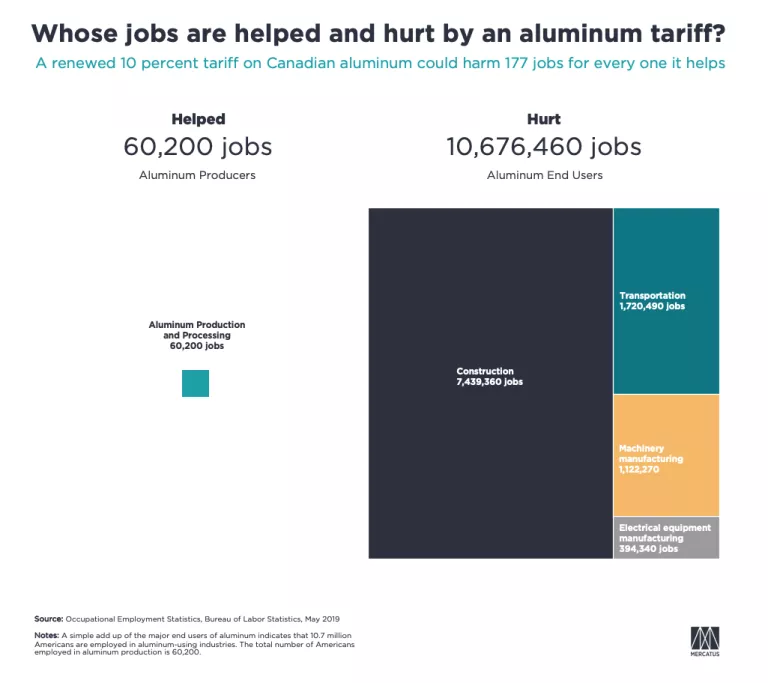- | Expert Commentary Expert Commentary
- |
Quick Reads: A Bad Deal for American Industry
Christine McDaniel shows how new aluminum tariffs may benefit a few producers but will raise costs and harm employment in many other industries
As soon as President Trump announced a renewed 10 percent tariff on imports of Canadian aluminum, Mercatus Center trade economist Christine McDaniel opened a spreadsheet, plugged in some government data, and found that jobs in aluminum-consuming industries vastly outnumber the workforce of protected US aluminum producers.
Employment for all occupations in aluminum oxide and aluminum production and processing is 60,200, according to the May 2019 federal Occupational Employment Statistics report. The same figure for payrolls in industries that are major users of aluminum—construction, transportation manufacturing, machinery manufacturing and manufacturing of electrical equipment, appliances and components—is nearly 10.7 million. The ratio of employment in aluminum-consuming industries to employment in aluminum production is a whopping 177 to 1. And the ratio is probably even more lopsided because the number of aluminum users excludes companies that are end users of the metal but do not fall within the major sectors listed.

“The president said that Canadian aluminum has flooded the American market and was poised to ‘kill all our aluminum jobs,’” McDaniel says. “But Bureau of Labor Statistics data show that far more people work in industries that use aluminum and that rely on globally competitively priced aluminum.”
Meanwhile, Canada has already issued plans to slap $3.6 billion Canadian dollars in tariffs on US products in retaliation. The retaliatory levies could target a list of goods including US refrigerators, wheel rims and golf clubs within 30 days. Canadian Deputy Prime Minister Chrystia Freeland said that the US tariffs will affect “any American who buys a can of beer or of soda, or a car or a bike.”
In 2018, McDaniel and fellow Mercatus economist Veronique de Rugy co-wrote “The Downstream Costs of Trade Remedy Regulations.” The policy brief showed how tariffs provide special protection for specific groups of domestic firms at the expense of downstream US industries.
“Import restrictions such as tariffs lead to higher prices on imported and domestic goods, which can provide the domestic firms with temporary ‘import relief’—a period of time during which they can charge higher prices as a result of import restrictions,” McDaniel says. “But the costs of those higher prices are largely shouldered by downstream American industries and users of the protected goods. Ultimately, those costs are passed on to manufacturers and consumers across the economy, who pay more for the everyday products they rely on.”
McDaniel points out that the new tariffs on Canadian aluminum, which are due to take effect on August 16, are a good example of this dynamic. “A small number of aluminum producers stand to benefit from higher prices, while a much higher number of aluminum users will suffer from higher prices,” she says. “And these higher input prices could not come at a worse time, as US businesses are already paying tariffs on steel, aluminum, and many Chinese imports, while the economy suffers from the pandemic-related shutdown. It’s no wonder that polls show Americans increasingly don’t like tariffs.”